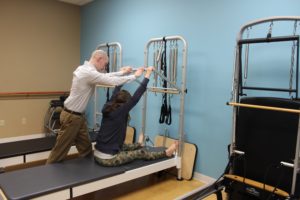I have been doing some reading lately after having discussions with people about whether exercise is helpful or harmful for those in pain. Do a search on Exercise and Pain and you will get back over 183 million hits. Clearly everyone has an opinion and has put material out there for viewing. But what is the answer?
Unfortunately there is not a nice, simple one. Many factors must be considered when attempting to answer this question.
To begin with, there are several different types of pain. Pain can be classified based on time (acute or chronic) as well as mechanism (nocioceptive, neuropathic, and central sensitization). Pain is a complex process and feeling experienced by the person so the answer to the question really is….IT DEPENDS.
Part of the IT DEPENDS hinges on whether there was some muscle/tendon/tissue damage. This could be a sprain, a pulled muscle, or following surgery. In these instances, caution is advised. Some rest time is likely advised (to allow healing), but there are certainly ways to be active under the guidance of a doctor or physical therapist.
The focus of this question really is those suffering with chronic pain. Chronic pain is defined as pain lasting greater than 3 months. For most injured tissues (muscle, tendon, ligaments) be is a sprain, a pulled muscle, or even post surgery, they will heal within this 3 month time window. So why then does pain persist beyond this “healing” curve?
This question takes us deep into the mechanisms of persistent/chronic pain and how/why people question whether exercise is good or bad. Pain that lasts more than 3 months becomes dysfunctional. Basically the body becomes extra sensitive to touch, movement, and activity in general. This means activity that used to not bother the person now seems painful. As a result the person tends to avoid more and more activity thinking it will result in pain. This action or inaction (activity avoidance) further enhances the pain process. As this process continues, the person finds it more challenging to accomplish simple daily tasks.
So…how then can exercise be incorporated in a way that seems positive? This requires an active approach from the start to limit this process. However, even in those who have long suffered with pain, it is still possible to reverse the process so that exercise or activity feels good again.
What must be done is to start with some simple task that the person wishes to accomplish, lets use walking in this case. Lets assume the person states it hurts to walk more than 10 minutes. So, begin walking 8 minutes. The goal is to return home FEELING good about accomplishing the task. Once the body and mind realize it is fine with 8 minutes then increased to 9 then 10 then 11 minutes. Even when it begins to hurt some, know that damage is not being caused. As one challenges this activity and returns home feeling accomplished and realizes they are not harming the body, then the pain response will begin to lessen. Meaning now the person does not hurt walking until 12-15 minutes. This process can be applied to any activity the person believes is harmful or hurts.
As part of this process, good chemicals are released in the brain to help the person feel accomplished. The more the person can tap into these good chemicals, they will then begin to reverse the process and start to feel better about activity and exercise.
So bottom line, YES, exercise is good for everyone. The specific activity, the level, frequency, or intensity can be modified as necessary. For those struggling to find their way into an exercise program because of pain or concern for pain, start the conversation with your doctor or therapist and learn to more. Not sure how what to do, get more answers by starting here 1st.
